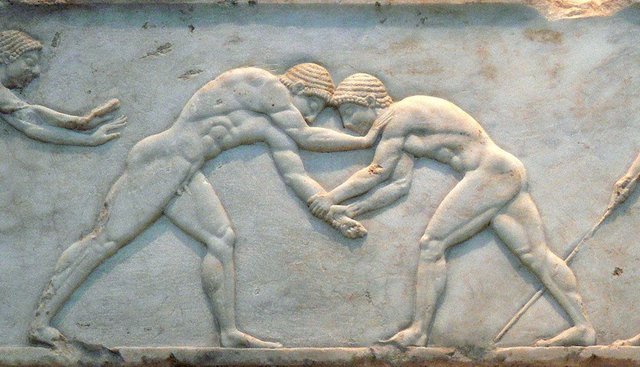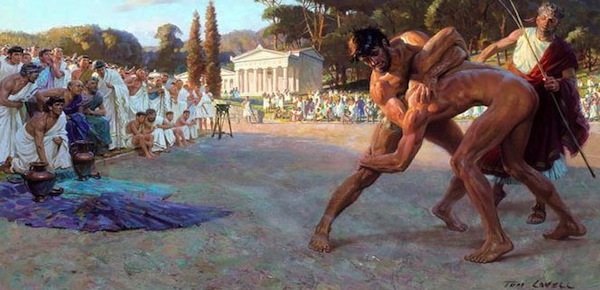
One of the oldest combat disciplines, or perhaps, the oldest in the world.
Since the Paleolithic era was practiced the fight, different graffiti dating back to the Paleolithic period, depict techniques and actions, starring the first fighters. Archaeological finds that have come down to us, highlighting this discipline, accompany us on a journey that touches all the major ancient civilizations. Sumerians, Egyptians, Greeks, Romans, Celts and Arabs, all practiced the art of "making arms".
The first evidence comes from Mesopotamia, Egypt and we have traces of this form of combat dating back more than 5000 years ago in the Sumerian civilization.
Several reasons have led to the development of this discipline, from the educational-formative to the military, defense and sports. The first traces of "codified fight" are found on the Egyptian tomb of Beni Hassan, dating back to 3000 BC. In which are represented as many as 400 different positions of fight with gymnastic-military purpose, reminiscent of the "modern free" in the standing phases and the "grapling no-gi" in the phases of fight on the ground.
Later, the Hellenic civilization has reported extensive documentation in which the fight was a fundamental exercise for strengthening the physical and character of young people.
In ancient Greece, however, there were mainly four styles of wrestling practiced, more similar to today's wrestling rather than the modern Greco-Roman.The standing fight was called with the appellation "Katazletiké", from the Greek term Katazalein "the art of throwing to the ground". The phases on the ground, included reversals, twists, joint levers and strangulations, which made it similar to the modern no-gi grappling. The Orthopali, however, was a fight similar to the modern freestyle, where they were allowed to trip and the use of the legs, the goal was to throw the opponent to the ground three times. Then we find the alindissis, also known as kylissis, was generally used in training for the long duration of the encounter and was fought in a ditch filled with sand. The fourth style, the one that was inherited on a large scale from the Romans, was the Pankatrion, a type of fight particularly violent, so as to be on the borderline between sport and war exercise. The Olympic wrestling was born in 708 BC. On the occasion of the XVIII edition of the Olympics, where the first winner was the Spartan Eurybates. Among the greatest champions of ancient Olympic wrestling we remember Milone of Crotone, who won six times, from 540 BC. To 516 BC.
The sporting character typical of the Athenian fight, disappeared in the Roman fight that was inspired more faithfully to the Spartan fight, more inclined to a warlike application than sporting.
In the Roman period the fight had become to all intents and purposes an activity for professionals (or soldiers), who challenged each other in the arenas against other wrestlers from different provinces of the empire.
In 394 the Emperor Theodosius I, put an end to the Olympic Games, causing the interest in wrestling to wane, but despite this, the discipline continued to evolve until the Middle Ages, where it was trained contemplating very few rules and intended mostly for use in war.
Between the tenth and fifteenth centuries, wrestling regained visibility in Hungary, Italy and the Alpine valleys, as an art of entertainment and self-defense. In France, wrestling was practiced by kings, who often organized meetings to measure strength and skill. Memorable is the meeting between the King of France, Francis I, and the King of England Edward VIII, ended with the victory of the French king.
1800 represented an important period for the rebirth of the fight and its popularity, in this historical period began the phase of the "modern Olympic fight". France played a key role in the revival of wrestling, with the opening of real academies dedicated entirely to the study of wrestling. In the same years were born important schools in Italy, mainly in Milan, Genoa and Turin. In that period Turkey and the Balkan countries (Bulgaria, Romania, Albania and Yugoslavia) also played a fundamental role in the development of Olympic wrestling.
In the Europe of 1800-'900 in addition to a large number of academies were born especially the first federations, starting in 1891 with the federation of German wrestling.
In 1894, Baron Pier de Coubertin, reopened the Olympics, where the major nations channeled the sports movements, in sports organizations aimed at participation in the Olympic Games. The Greco-Roman entered to be part of the games since their first edition in 1896, while the free entered to be part of the games in 1904.
In 1912 the International Federation of Wrestling (FILA) was born and with it officially began the other international competitions such as the European and World Championships.
Alongside the Olympic disciplines, FILA also added other styles such as no-gi grappling.
The fight, even today, is used for sporting purposes and as a means of self-defense for civilians and military, as it was in ancient times.
Currently, Olympic wrestling is practiced in 160 countries and is a national sport in several countries, such as Turkey, Iran, Georgia, Armenia, USA, Mongolia, Gambia, Russia and in many countries of the bloc belonging to the former USSR.
